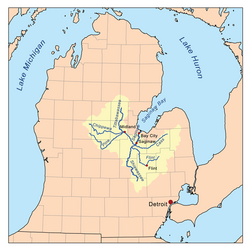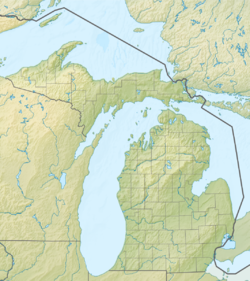
Back نهر تيتاباواسى ARZ Tittabawassee River CEB Tittabawassee River German Río Tittabawassee Spanish Tittabawassee (rivière) French
| Tittabawassee River | |
|---|---|
 Looking north from M-61 in Hay Township | |
 Saginaw River watershed | |
| Physical characteristics | |
| Source | |
| • location | Edwards Township, Ogemaw County, Michigan |
| • coordinates | 44°05′27″N 84°18′49″W / 44.09085°N 84.31361°W[1] |
| Mouth | |
• location | Saginaw River, Michigan |
• coordinates | 43°23′12″N 83°57′58″W / 43.38669°N 83.96608°W |
| Length | 72 mi (116 km) |
| Basin size | 2,471 sq mi (6,400 km2) |
| Discharge | |
| • location | mouth |
| • average | 2,055.61 cu ft/s (58.208 m3/s) (estimate)[2] |
The Tittabawassee River (/ˈtɪtəbəˈwɑːsi/ TIH-tə-bə-WAH-see) flows in a generally southeasterly direction through the Lower Peninsula of the U.S. state of Michigan. The river begins at Secord Lake in Clement Township, at the confluence of the East Branch and the Middle Branch.[3] From there it flows through Gladwin, Midland and Saginaw counties where, as a major tributary of the Saginaw River, it flows into it at Saginaw. Its tributaries include the Chippewa, Pine, Molasses, Sugar, and Tobacco rivers.
Significant communities on or near the Tittabawassee River include Saginaw, Midland, and Sanford. At Edenville, the river was impounded by the hydroelectric Edenville Dam to create Wixom Lake. It was also impounded by a hydroelectric dam in Sanford to create Sanford Lake prior to the dam failures and resulting flooding on May 19, 2020. In Saginaw County, the river flows through Tittabawassee Township, which is named for the river and contains the unincorporated community of Freeland.
The main river is 72.4 miles (116.5 km) long[3] and drains an area of 2,471 square miles (6,400 km2).[4]
- ^ "Tittabawassee River". Geographic Names Information System. United States Geological Survey, United States Department of the Interior.
- ^ United States Environmental Protection Agency. "Watershed Report: Tittabawassee River". WATERS GeoViewer. Archived from the original on July 5, 2021. Retrieved July 5, 2021.
- ^ a b United States Geological Survey. "National Hydrography Dataset high-resolution flowline data". The National Map. Archived from the original on March 29, 2012. Retrieved November 7, 2011.
- ^ "Tittabawassee River Assessment" (PDF). Michigan Department of Natural Resources. Archived (PDF) from the original on April 1, 2012. Retrieved May 5, 2011.
